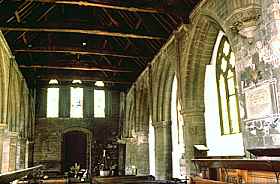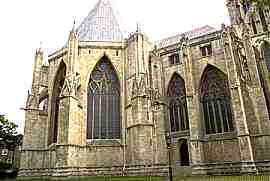 |
| Paleography
Exercises |
|
Appeal
to the Holy See of 1281 from the collection of Rob Schäfer. All
images © Rob Schäfer. |
|
 |
This
notarial document
is an appeal by the prior and convent of Holy Trinity, York to the Holy
See, against the archbishop of York. The archbishop had refused to appoint
as rector to the church of St Helen in Fishergate, in the suburbs of York,
the candidate recommended by the prior, despite the priory believing it
held the right to appoint. |
|
There
are a number of interesting features of the document. The use of notaries
was not the normal procedure in England, and is used here because this
is papal business. The form of the document, including the use of the
notary's mark, the elaborate dating clause and certain aspects of the
calligraphy,
has more in common with generic ecclesiastical documents than with specifically
English documents. The script
is a Gothic
minuscule,
but with neat, spaced, rounded letters which retain much in common with
Caroline
minuscule. The use of rather tall and elaborate ascenders
and descenders
is also a feature of ecclesiastical documents. This is not the most formal
grade of document, so those particular features are moderate. |
|
Historically,
it demonstrates the autonomy of the church in regulating its affairs, wherever
they might reside. One little difference of opinion with the archbishop over
a small matter involving a relatively insignificant urban parish church, and
the whole dispute goes straight off to Rome. No secular authority in England
intervenes. |
 |
Very
little survives of the priory of Holy Trinity. Part of the church was
converted to parish use at the Reformation and can be seen along the fine
street of Micklegate. All the conventual buildings have disappeared. As
an alien priory, or cell of a Benedictine mother church in France, it
was always the lesser Benedictine institution in York, taking second place
to the great St Mary's Abbey. |
|
Interior
of Holy Trinity church. |
|
St
Helen's church in Fishergate was demolished in the 16th century, along
with many other churches in York, which had something of an excess for
its needs. It is recorded as having been presented to the priory at its
foundation. One might think of the term suburb as having a modern connotation,
but in York, as in other medieval towns, it was used to describe the permanently
inhabited areas outside the town walls. In York, these were quite extensive. |
 |
The
document claims to have been "enacted in the greater church of York in
the place where justice is accustomed to be delivered". This presumably
refers to the chapter house of York Minster, right in the territory of the
archbishop who is being complained about. |
|
The
chapter house of York Minster. |
|
So
with all the circumstantial preliminaries out of the way, let's look at the
document. |
|
| overview | initial | notary's
mark | text | alphabet
| abbreviations | structure
| exercises | |
transcript
| translation
| |
|
Click
on each of the above to walk your way through the text. The transcript will
appear in a separate window so that you can use it for reference at any time.
These exercises are designed to guide you through the text, not test you,
so you can cheat as much as you like. |
 Script sample for this example Script sample for this example |
 Index
of Exercises Index
of Exercises |
 Index
of Scripts Index
of Scripts |
|
 |
 |
 |


